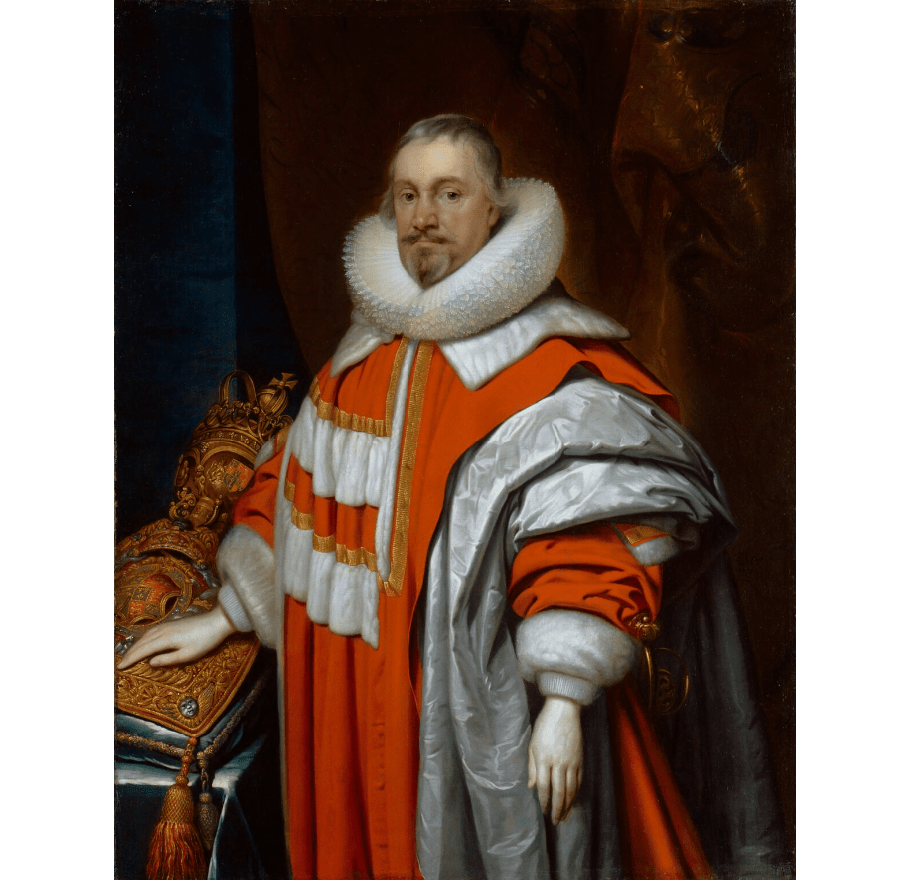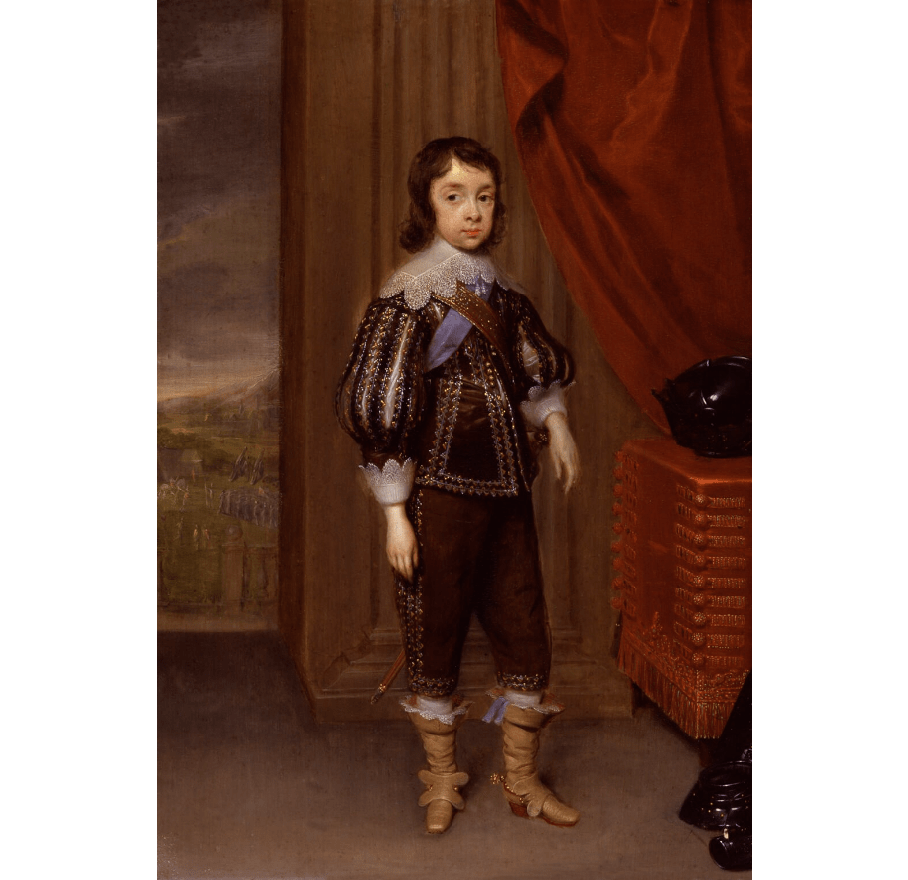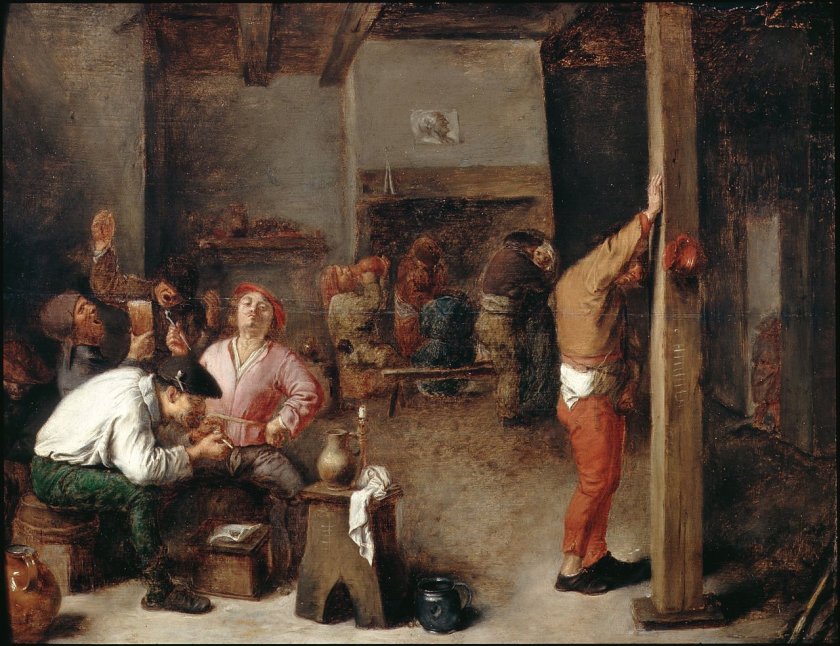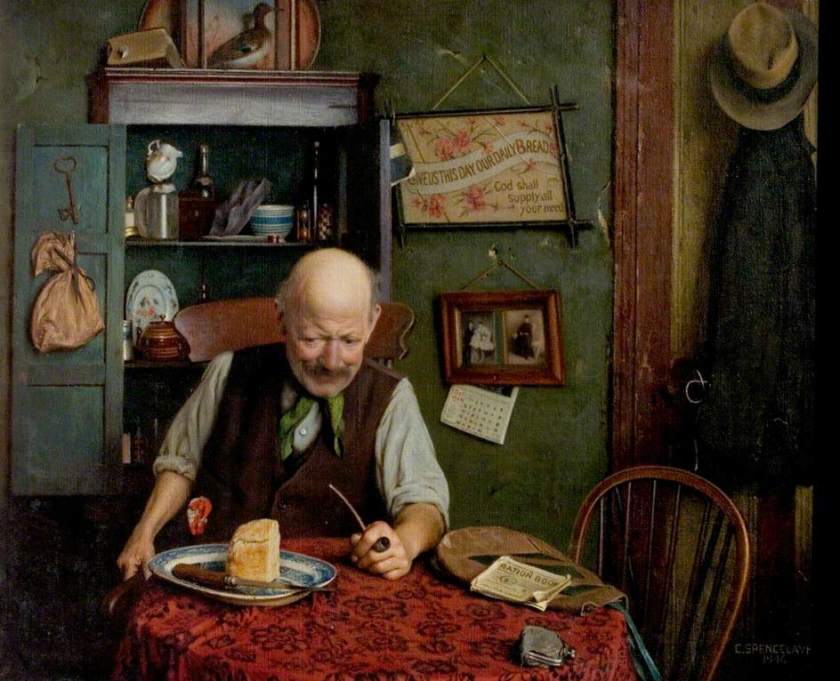Portraiture is an art form which goes back to ancient times and before the advent of photography it was the only way to chronicle the appearance of someone. However the way the sitter was portrayed by the artist afforded them the illusion of power, importance, virtue, beauty, wealth, taste, learning or other qualities of the sitter. Often it was the artist’s “duty” to depict the sitter in a flattering way, although some portraitists, like William Hogarth, refused to flatter, and would often have their works rejected by the person who had commissioned the portrait. The artist I am featuring in today’s blog was one of the leading portrait artists of the seventeenth century. He painted everything from miniatures to small scale royal portraits, portraying aristocracy, lawyers, gentry and merchants
Cornelius Johnson or Cornelis Janssens van Ceulen (Cologne) was born in October 1593 in London to a Flemish/German protestant family . He was baptised at the London Dutch Reform Church at Austin Friars much used by the Netherlandish community in London. His father was Cornelius Johnson who had been a religious refugee from Antwerp and his paternal grandfather had come from Cologne. His mother was Johanna le Grand. It was thought that Cornelius could have received his first artistic training, whilst in the Netherlands, from Michiel Jansz. van Mierevelt. It is known that Cornelius had definitely returned to England by 1619 for it is recorded that he was a witness at the baptism of his nephew, Theodore Russell. During the 1620’s he lived and had his studio in the London parish of St Ann, Blackfriars, as did the other leading portraiture artist, Anthony van Dyck and the English father and son miniaturists, Isaac and Peter Oliver.

His earliest paintings date from 1619 and soon he had created a large number of portraits with his sitters coming from various upper levels of society. One of his early works was a portrait of Alathea Talbot, Countess of Arundel, a famous patron and art collector, and one of England’s first published female scientists. She was the third daughter of George Talbot, 7th Earl of Shrewsbury, K.G. and his step-sister Mary, daughter of Sir William Cavendish, who married in 1606 Thomas Howard, Earl of Arundel. Johnson has depicted the countess wearing a red dress trimmed with lace with a white lace collar and a gold earring with a blackbird pendant in her right ear.
On July 16th 1622 at the Dutch Church in London, Cornelius married Elizabeth Beke, a lady from a migrant family based in Colchester. Their first son, James, was born on September 30th 1623 but died young. Another son, Cornelius Junior, was born in London in August 1634 and went on to follow in his father’s footsteps, and become a painter.
During the 1620’s his fame as an artist soon spread. Johnson’s most constant client was a lawyer, Thomas, 1st Baron Coventry of Aylesborough, a prominent English lawyer, politician and judge. He sat for Johnson on at least five different occasions during the 1620s and 1630s. This portrait, shows him with the bag of the Lord Keeper of the Great Seal, and the mace of the Speaker.

Cornelius Johnson painted the portraits of many senior legal figures including Sir John Finch. Finch was Speaker between 1628–1629. On 10 March 1629, as Speaker, he tried to adjourn the House of Commons on the King’s command, following a disagreement between the King and Members of Parliament over King Charles I’s belief that by the royal prerogative he could govern without the advice and consent of Parliament. Civil War was creeping ever closer.

Another dignitary to sit for Johnson was Lady Margaret Hungerford, the daughter of a wealthy London alderman who had married Sir Edward Hungerford in 1621. Her husband owned vast tracts of land in England and were spent much of their time at Corsham House in Wiltshire and Farleigh Hungerford Castle in Somerset. We see the sitter wearing an orange patterned dress with a large white lace collar, a gold-and-black jewel necklace and an orange flower in her hair. In the top right-hand corner of the picture, there is a coat of arms. It is a sumptuous depiction of the details of the costly lace, her embroidered and spangled dress and silver braided ribbons, topped off with expensive jewellery. It must have taken Johnson many hours to perfect the depiction.
Cornelius Johnson collaborated with Daniel Mytens, a Dutch Golden Age portrait painter, in a full-length portrait of the monarch, Charles I, in 1631. Mytens had moved from the Netherlands to London in 1618 and had become one of James I and Charles I’s court painters. In the background is a view of Windsor Castle and at the king’s feet is his trusty King Charles spaniel.

In 1632 Johnson was appointed one of King Charles I’s court painters. The appointment was termed
“…his Majesty’s servant in ye quality of Picture Drawer to his Majesty…”
Around 1634 Daniel Mytens returned to the Netherlands where he worked and continued to paint but also was an art dealer in The Hague. This you may think gave Johnson the advantage as being the lead court painter but it was not to be as another artist came on to the scene. Of all the Stuart kings, Charles I was the most passionate collector of art as he viewed paintings as a way of endorsing the lofty view of the monarchy. Antwerp-born, Anthony van Dyke arrived in England in April 1632. It was not van Dyke’s first time in London as he had spent six months there at the end of 1620 before heading off to Italy. Although he was travelling around Italy Van Dyck remained constantly in touch with the courts of James I and Charles I’s and whilst travelling around Italy he helped King Charles’s agents in their search for paintings. He also sent to England some of his own works. In April 1632 van Dyck returned to London and immediately became a court favourite as well as being welcomed by king Charles who knighted him in July and set out that van Dyke should receive a pension of £200 a year The wording of the grant document referred to Van Dyke as principalle Paynter in ordinary to their majesties. He was provided with a house on the River Thames at Blackfriars, then just outside the City of London, thus avoiding the monopoly of the Worshipful Company of Painter-Stainers. Van Dyke’s Blackfriars studio was frequently visited by the King and Queen and later a special causeway was built to ease their access from the river. Charles rarely sat for another painter while van Dyck lived.
The artistic trajectory of Cornelius Johnson was stalled.
In 1639 Johnson received a royal commission to paint the three young children of Charles I and his French princess wife Henrietta Maria. First was a portrait of Charles’ eldest son, Charles, who would later become Charles II. It depicts the nine year-old-boy as a boy soldier, which appears to be a powerful piece of propaganda. Charles I was executed in January 1649 at the climax of the English Civil War and the country became a de facto republic led by Oliver Cromwell. When Cromwell died in 1658, the English monarchy was restored and Charles II became monarch on his thirtieth birthday on May 29th 1660.
Cornelius Johnson painted the portrait of Charles I’s second son, James, when he was six-years-old. It was not until forty-six years later, in 1685, on the death of his brother, Charles II, that he became king of England.

The third 1639 royal portrait by Johnson was of the English princess, Mary, who was the eldest of Charles I’s children and the sister of Charles II and James I. She was eight years old at the time of the painting.

Two years later, in 1641, Mary who was just nine years of age was married to the future stadtholder of the Netherlands, fifteen-year-old William II of Orange. Eight days after her husband’s death in 1650, Mary gave birth to a son, William III of Orange, who later became King of England. After the restoration of the monarchy in England in 1660, Mary left the Netherlands to join in the celebrations in London, where she fell ill with smallpox and died, aged 29.

Johnson painted many portraits of children, either individually or in pairs, and consequently was much in demand with English and Scottish clients. An example of this genre was Johnson’s 1635 portrait entitled Robert, Lord Bruce, later 2nd Earl of Elgin and 1st Earl of Ailesbury. We see before us a fashionably dressed young sitter, Robert, Lord Bruce, who was the only child and heir of the Scottish nobleman Thomas Bruce, 1st Earl of Elgin. As a young child, Bruce received little formal education, but once he became a teenager, he travelled to Europe and was one of the first Scots to embark on the Grand Tour. By 1659, twenty-three-year-old Bruce had become an active royalist conspirator and was involved in plans for an uprising against the government, which led to his arrest.
The portrait had been commissioned by the boy’s father, Thomas Bruce. One must believe that Thomas Bruce was pleased with the resulting portrait of his son as three years later, in 1638, he commissioned Johnson to paint a full-length portrait of himself.

The community that Cornelius Johnson lived among centred itself around the Austin Friars, the Dutch church in London. At the time of the late sixteenth century the Dutch community was the largest group of expatriates living in London and numbered around five thousand out of the total population of one hundred thousand at the time. About half of the Dutch residing in London were Protestants who had fled the Flemish Low Countries due to religious persecution. Others were skilled craftsman, including brewers, tile makers, weavers, artists, printers and engravers, who came to England for economic opportunities. Johnson was commissioned to paint portraits of many of these distinguished members of this Netherlandish community.

One such pair were Willem Thielen, the Minister of Austin Friars, and his wife Maria de Fraeye.

From left to right: Arthur Capel 1st Earl of Essex (1631-1683), his father Arthur Capel 1st Baron Capel (1604-1649), Henry Capel 2nd Baron Capel (1638-1896), Elizabeth, Lady Capel (died 1661), Charles Capel (died 1657), Elizabeth Countess of Carnarvon (1633-1678), and Mary Duchess of Beaufort.
It was around 1640 that Cornelius John received the commission to paint a large family group portrait of the 1st Baron Capel and his wife and their five surviving children. It is a depiction which celebrates fecundity, good health, good looks and stylish elegance. Lord Capel was a diehard Royalist. Appropriately, given the horticultural interests of the Capels, the family are pictured here posing in front of their formal garden at Little Hadham Hall in Hertfordshire. The baron’s wife is dressed modestly and somewhat behind the times. She is seen wearing a two-tiered cape trimmed with lace to conceal her bodice, but her daughters wear lace collars that were démodé for about five years.

The set-up for Cornelius Johnson’s depiction of the Capel Family was thought to have come from van Dyke’s 1632 depiction of Charles I and his family.
Anthony van Dyke died in 1641 and this should have added to the opportunities for Johnson whose work and reputation had been overshadowed by van Dyke. However, Johnson was not to have that boost in England because at the time of van Dyke’s death the political situation in England was fast deteriorating and by 1642 Charles I had fled from London. George Vertue, an English engraver and antiquary, whose notebooks on British art of the first half of the 18th century are a valuable source for the period, in October 1843 he wrote of Cornelius Johnson’s predicament:
“…being terrifyd with those apprehensions & the constant perswasions of his wife, the family emigrated to the Netherlands…”
In Alexander Finberg’s 1922 book A Chronological List of Portraits by Cornelius Johnson he talks about Johnson’s “pass”, parliamentary permission to travel and leave England. Finberg wrote:
“…Cornelius Johnson, Picture Drawer, shall have Mr Speaker’s Warrant to pass beyond the seas with Emmanuel Pass and George Hawkins and to carry with him such pictures and colours, bedding, household stuff, pewter and brass as belonged to himself…”
On October 27th 1643 Johnson left London and sailed to Middelbourg, Zeeland, a city in Southwest Netherlands. Middlebourg was part of the The United Provinces often referred to as Netherlands, or the Republic of the Seven United Netherlands.
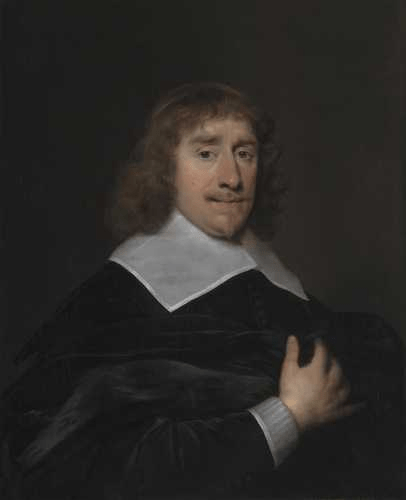
Once residing in Middelbourg Johnson joined the painter’s guild, The Guild of St Luke. One of Johnson’s first commissions was a lucrative and prestigious one. It came from Apolonius Veth, who was the burgomaster of Middelbourg.

Apolonia Veth also commissioned Johnson to paint a portrait of his wife, Cornelia.

For a time, Cornelius Johnson and his family left Middelbourg and went to live in Amsterdam. Cornelius carried on with his portrait commissions but also took on multi-figure commissions. One such was his 1647 painting entitled The Hague Magistrates.
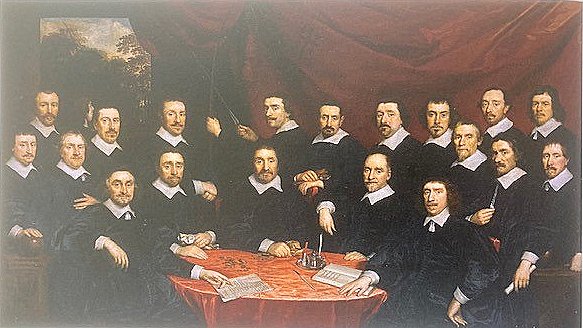
Another of Johnson’s multi-figured civic portraits was his 1650 painting entitled The Middelburg Archers’ Guild. One presumes the Guild commissioned Johnson for the painting. Johnson’s old client Apolonius Veth was Deacon of the Guild the year Johnson worked on the painting so, as he appears in the depiction, maybe he was the person who commissioned the work.
During 1652 Johnson relocated his family to Utrecht and resided in the high-status address of Herrenstraat. Portrait commissions kept rolling in from the elite families of Utrecht and Johnson was soon regarded as a leading portrait painter. Cornelius Johnson sometimes known as Cornelis Jonson van Ceulen died on August 5th 1661, aged 67 and the funeral service was held in the Regulierskerk in Utrecht

